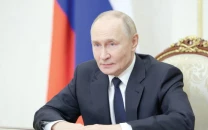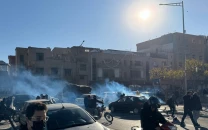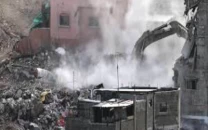Taliban equate planned American exit to Soviet defeat
Fears surface that the US withdrawal mirrors the Soviet withdrawal from Afghanistan almost 23 years ago.

Taliban equate planned American exit to Soviet defeat
"Selfish Americans must learn a lesson from ... the Russian defeat and no longer fight a meaningless battle with zealous Afghans and take their invading forces out as soon as possible," the Afghan Taliban said in an e-mailed statement to media.
Forces from the former Soviet Union exited Afghanistan in 1989 after handing over security to a shaky government that was quickly beset by heavy fighting led by mujahideen groups, many of which were initially aided by the United States and Pakistan.
Now the United States and NATO are racing against the clock to train a 350,000-strong force of Afghan police and soldiers who will take over all security responsibilities before end-2014, though scepticism looms that the target can be met in an increasingly violent war.
"Today's American occupying invaders and their coalition allies are facing the same future the Russian invaders faced in the past," the Taliban statement added, referring to the NATO-led war now dragging into its eleventh year.
Comparing the two wars is not limited to Taliban hype - fears are surfacing amongst Afghans and analysts that a repeat of the aftermath could take place.
"When the Soviet troops left, it was both a military and economic withdrawal. And once Americans leave, everything else will go with them," said Mir Ahmad Joenda, who was a member of the Afghan parliament during Communist times and now works at the country's Civil Society Forum.
"There is a definite possibility of a repeat of 1989 and its aftermath," Joenda told Reuters.
Afghans - even those of opposing political sides – hold intense pride over the forced withdrawl of the former Soviet Union after a decade of war.
Afghan state TV showed rolling footage of Red Army troops atop armoured vehicles crossing a bridge at the former Soviet northern border on Feb. 15 1989, an image that has become synonymous with the end of a war that still haunts Moscow and cost 15,000 Soviet lives fighting mujahideen insurgents.
After the dispirited Soviet exit, the Afghan communist government collapsed, leading to infighting between warlords and a vicious civil war that reduced much of Kabul to rubble and paved the way for the Taliban's rise to power in 1996.
“NATO leaving behind an impoverished country”
Washington has pledged military support and aid -- though at much reduced levels that the billions of dollars spent now -- well after its troops withdraw, much as the Soviets continued to prop up the Communist government of Mohammad Najibullah after their 1989 rush from the country.
But when the Soviet Union collapsed two years later, the aid vanished, Najibullah was ousted in 1992, and in the ensuing war two thirds of Kabul was razed and about 50,000 civilians died.
"Like the Soviets, NATO will be leaving behind an impoverished country crippled by corruption, a government whose writ doesn't extend to many places outside Kabul, and where insurgent fighters are presumably waiting out foreign forces to assert themselves," said Gregory Feifer, author of The Great Gamble, which examines the Soviet war in Afghanistan.
But unlike the Soviet exit strategy, Afghan and US officials are seeking peace negotiations with the Taliban as a means to ushering in some form of stability when foreign combat troops leave though the talks lay in a very fragile state.
Alexander Golts, a military analyst in Moscow, said there was "no doubt" the Taliban would regain a share of power following the NATO pullout, and predicted it would occur more quickly for the austere Islamist group the second time round.
"American and NATO forces will leave Afghanistan with limited success, which means we cannot be absolutely sure that in two, three or in five months' time, the Talibs will not return to power".



















COMMENTS
Comments are moderated and generally will be posted if they are on-topic and not abusive.
For more information, please see our Comments FAQ